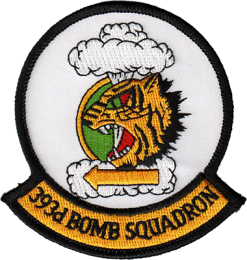
No squadron played a more dynamic role in achieving a decisive victory in World War II and in the maintenance of a lasting peace than the 393d Bomb Squadron (BS). The proud history of this unit began with its constitution as the 393d Bombardment Squadron (BMS) on February 28, 1944 by the Army Air Forces(AAF). The AAF then activated the 393 BMS on March 11, 1944 and assigned it to the 504th Bombardment Group at Dalhart Army Air Field (AAFld), Texas, with Lieutenant Colonel Thomas J. Classen as the first commander. Originally, the 393 BMS was equipped with B-17s, however, fate intervened when Colonel Paul W. Tibbets, Jr., selected the newly formed unit to participate in a very special mission. On September 14, 1944, the squadron moved to Wendover Field, Utah, and began training on the massive B-29. Colonel Tibbets took formal command of the 393d on October 8, 1944, and on December 17, 1944, following creation of the 509th Composite Group (CG) by the Army Air Forces, became overall commander. The 393d was assigned to the 509th with Colonel Classen as commander.
Training on the B-29s continued and on April 26, 1945 the squadron moved to its overseas home on North Field, Tinian, the Marianas. Soon after officially arriving at the field on May 30, 1945, the 393 BMS began flying a series of missions consisting of two or three B-29s each carrying one large, orange coloured bomb they dropped on targets throughout Japan. These projectiles added realism to the missions as they emulated the flight characteristics of an atomic bomb. By early August 1945, the 509 CG and 393 BMS were ready to complete their secret mission. In the early morning hours of August 6, 1945, Colonel Tibbets took off from North Field flying the B-29 the Enola Gay. The aircraft flew over Hiroshima, Japan, and released the first atomic bomb. Within seconds, a huge mushroom cloud engulfed the city. Even after this startling show of power, the Japanese Empire still refused to surrender. Hence, three days later, another 393 BMS B-29 took off loaded with a second atomic bomb. Major Charles W. Sweeney, 393 BMS Commander, flew the B-29 Bock's Car, over Nagasaki to deliver another devastating blow. A few days later, the Japanese sued for peace.
The squadron remained at North Field until October 17, 1945 when the 509th returned to the United States and proceeded to their new home, Roswell AAFld (later Walker AFB), New Mexico. Because of its expertise with the atomic bombs, the unit became the core organization of the newly created Strategic Air Command (SAC), on March 21, 1946. The squadron remained at Roswell until the 509th CG was directed to Kwajalein, Marshall Islands in 1946, for Operation Crossroads, an atomic explosion test. Although the squadron did not drop the bomb, it waited in reserve as a back-up to its sister squadron, the 715 BMS. After the squadron returned to Walker AFB, it continued to fly and train in B-29s until 1952 when the 393d welcomed a new aircraft, the B-50 and was reassigned directly to the 509th Bombardment Wing. In 1955, the unit pioneered a new chapter when it began receiving SAC's first all-jet bomber, the B-47.
In 1958, the 393 BMS, along with the 509th Bombardment Wing, moved with personnel and equipment to Pease AFB, New Hampshire. Seven years later, in 1965, SAC announced the squadron would be inactivated following phase-out of the B-47s from the Air Force. However, fate intervened when SAC decided to keep both the 393d and the 509th active and replace the aging B-47s with B-52s. The squadron officially received its first B-52 on March 23, 1966.
In November 1966, several crews and aircraft from the 393d deployed to Andersen AFB, Guam. While there, the squadron's representatives participated in Vietnam ARC LIGHT operations. An urgent need for the bombers in the war prompted SAC to deploy all 393 BMS crews and aircraft to Andersen again in April 1968. During the six-month stay, the squadron participated in many bombing missions. A year later, SAC issued another call and once more the 393d aircraft and personnel went to Southeast Asia.